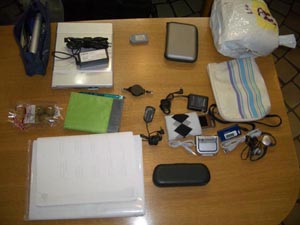From September 2005 to June 2006 a team of thirteen scholars at the The University of Southern California's Annenberg Center for Communication explored how new and maturing networking technologies are transforming the way in which we interact with content, media sources, other individuals and groups, and the world that surrounds us.
This site documents the process and the results.
categories
Power to the Cyborgs
Jill Walker and Noah Wardrip-Fruin are editing a new edition of Ted Nelson's Computer Lib/Dream Machines. They asked me to write a little essay for the "Stuff You May Run Into" section near the back of the Computer Lib side. The book came out before my time, but the lore about it was still in the air when I started nibbling on the edges of geekdom in the early nineties. So it was fun to get invited to this project. Luckily Scott had held on to his first edition so I could see the book in its original glory. The new edition should be a run update with lots of folks contributing pieces to augment and update Ted's manifesto. My contribution is appended here.
Portable Computers
Whether you call it called pervasive, ubiquitous, wearable, or (my preferred term) portable computing, the computational things you run into when you leave your home and office are infiltrating more and more of the chinks and cracks of everyday life. Ride a train in Tokyo and try to see how many computers you can spot. You’ll definitely see lots of portable phones held in one hand resting on a knee. The computer user will be reading something off the screen or typing a URL or an email into the numeric keypad. Look at the advertisements hung on every surface of the train, and you’ll see funny square symbols meant to be snapped with your camera phone to bring up a URL. Writing in the seventies, Ted was already clueing in to the quiet influx of computational tags on everyday objects, aggregating transactions in diverse places into digital databases. Now, these data and transaction systems can be uploaded and viewed by the computers in a teenager’s pocket. Moving on, maybe you will also register the number of headphones leading to MP3 players hung around the neck or plugged into the depths of a backpack or a shoulder bag. Keep looking. If you’re riding in the right time of day, you’ll see some Tamagotchi hanging around the necks of children. Maybe they will be beaming each other virtual goodies through the infrared on the little egg-shaped toys. Likely if there are kids on board you’ll see a portable game device or two. Or maybe a group of boys is checking out each other’s trading cards. Computers? Well, maybe not exactly, but notice the numeric codes at the bottom of the cards that can be inputted into game devices to materialize the cards in the virtual playing field. I’m an anthropologist, so I get to do nosey things like ask people to dump the contents of their bag out for me to photograph. What you don’t see as a casual passenger are the snarls of cables, digital cameras, the phone chargers, key cards, and digital cash cards tucked out of sight. These little devices are constant companions and extensions of identity, worn on or close to the body, creating sonic cocoons, private communication spaces, or interfacing with the urban environment.  Unlike the desktop computer incubated by a geek priesthood, these little devices packed and pocketed came into being as mass consumer technologies, already imbricated in the popular cultures of socializing, gaming, and style. It was Japanese teenage girls, after all, who hijacked pagers and portable phones from salarymen in the early nineties, and went on to help shape what came to be known as the mobile revolution. But the story doesn’t stop on the streets of Tokyo, Seoul, or Helsinki. Nowadays, China and India are where the ambitions of mobile operators have turned. Its not just Japanese teens for whom the portable phone was the first personal computer. The wave of wireless and portable computing is engulfing countries that lacked widespread telephone usage, much less computer access. Computers for the masses! Power to the cyborgs!
Unlike the desktop computer incubated by a geek priesthood, these little devices packed and pocketed came into being as mass consumer technologies, already imbricated in the popular cultures of socializing, gaming, and style. It was Japanese teenage girls, after all, who hijacked pagers and portable phones from salarymen in the early nineties, and went on to help shape what came to be known as the mobile revolution. But the story doesn’t stop on the streets of Tokyo, Seoul, or Helsinki. Nowadays, China and India are where the ambitions of mobile operators have turned. Its not just Japanese teens for whom the portable phone was the first personal computer. The wave of wireless and portable computing is engulfing countries that lacked widespread telephone usage, much less computer access. Computers for the masses! Power to the cyborgs!
.
.
